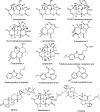A Multifaceted Review of Eurycoma longifolia Nutraceutical Bioactives: Production, Extraction, and Analysis in Drugs and Biofluids
- PMID: 36687023
- PMCID: PMC9850716
- DOI: 10.1021/acsomega.2c06340
A Multifaceted Review of Eurycoma longifolia Nutraceutical Bioactives: Production, Extraction, and Analysis in Drugs and Biofluids
Abstract
Eurycoma longifolia Jack (known as Tongkat Ali) is a popular traditional herbal medicine, native to southeast Asia, that is well-known for its aphrodisiac as well as several other effects. Mostly, the root extract of E. longifolia is used as a folk medicine for sexual dysfunction, aging, anxiety, exercise recovery, fever, increased energy, and osteoporosis. These health effects led to the inclusion of E. longifolia in dietary supplements, particularly for bodybuilding purposes. These effects are mediated by a myriad of bioactive compounds belonging to quassinoids, canthin-6-one alkaloids, tirucallane triterpenes, squalene derivatives, and bioactive steroids. Among these phytoconstituents, quassinoids account for a large portion of E. longifolia root phytochemicals. Of these ingredients, eurycomanone, the major quassinoid in E. longifolia extract, accounts to a large extent for its health effects. This review capitalizes on the novel trends toward the production of E. longifolia bioactives using biotechnology and extraction optimization for best yields and recovery. Alongside, novel extraction methods, i.e., green techniques, of E. longifolia bioactives are described. Further, an overview of the different analytical approaches for the quality control assessment of E. longifolia plant material and nutraceuticals is presented alongside studies in body fluids to determine its pharmacokinetics and efficacy level. Such a compilation of analytical methods will help ensure safety and efficacy of that major drug.
© 2022 The Authors. Published by American Chemical Society.
Conflict of interest statement
The authors declare no competing financial interest.
Figures





Similar articles
-
Review on a Traditional Herbal Medicine, Eurycoma longifolia Jack (Tongkat Ali): Its Traditional Uses, Chemistry, Evidence-Based Pharmacology and Toxicology.Molecules. 2016 Mar 10;21(3):331. doi: 10.3390/molecules21030331. Molecules. 2016. PMID: 26978330 Free PMC article. Review.
-
Standardized quassinoid-rich Eurycoma longifolia extract improved spermatogenesis and fertility in male rats via the hypothalamic-pituitary-gonadal axis.J Ethnopharmacol. 2013 Feb 13;145(3):706-14. doi: 10.1016/j.jep.2012.11.013. Epub 2012 Dec 20. J Ethnopharmacol. 2013. PMID: 23261482
-
Simultaneous quantitation of six major quassinoids in Tongkat Ali dietary supplements by liquid chromatography with tandem mass spectrometry.J Sep Sci. 2015 Jul;38(13):2260-6. doi: 10.1002/jssc.201500207. Epub 2015 Jun 11. J Sep Sci. 2015. PMID: 25914245
-
Tongkat Ali (Eurycoma longifolia Jack): a review on its ethnobotany and pharmacological importance.Fitoterapia. 2010 Oct;81(7):669-79. doi: 10.1016/j.fitote.2010.04.006. Epub 2010 Apr 29. Fitoterapia. 2010. PMID: 20434529 Review.
-
Review Ergogenic Effect of Long Jack, Eurycoma Longifolia.Pharmacogn Rev. 2016 Jul-Dec;10(20):139-142. doi: 10.4103/0973-7847.194041. Pharmacogn Rev. 2016. PMID: 28082797 Free PMC article.
Cited by
-
Integrated comparative metabolite profiling via NMR and GC-MS analyses for tongkat ali (Eurycoma longifolia) fingerprinting and quality control analysis.Sci Rep. 2023 Feb 13;13(1):2533. doi: 10.1038/s41598-023-28551-x. Sci Rep. 2023. PMID: 36781893 Free PMC article.
References
-
- Murthy H. N.; Lee E.-J.; Paek K.-Y. Production of secondary metabolites from cell and organ cultures: strategies and approaches for biomass improvement and metabolite accumulation. Plant Cell Tissue and Organ Culture 2014, 118 (1), 1–16. 10.1007/s11240-014-0467-7. - DOI
- Rao S. R.; Ravishankar G. A. Plant cell cultures: Chemical factories of secondary metabolites. Biotechnology Advances 2002, 20 (2), 101–153. 10.1016/S0734-9750(02)00007-1. - DOI - PubMed
Publication types
LinkOut - more resources
Full Text Sources

